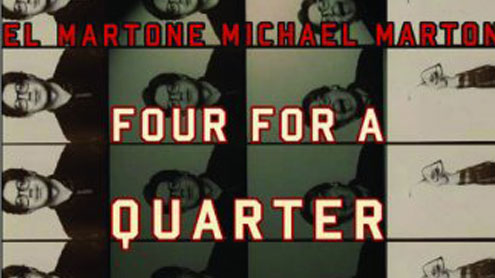 Creative Writing director Michael Martone’s new book is brought to you by the number four.
Creative Writing director Michael Martone’s new book is brought to you by the number four.
Martone began “Four for a Quarter” when he was 44 years old. It’s a collection of 44 short stores that relate somehow to the number four – the four seasons, the Four Horsemen of the Apocalypse, The Fantastic 4, etc. It’s divided into four parts, each containing four chapters. Each story is written in four sections.
And that’s it. No deep statement about the human condition. No emergent meta-arc. Just 2×2. ?16. Your regular ol’, no-frills, everyday IV.
“It just squares nicely,” Martone said.
Seem trivial? That’s the point.
“It becomes like a conversation,” he said. “If you have four dots, can you create a picture? An emotion?”
The front cover features a photo booth that inspired the books title and first story. It’s the kind you find at carnivals in the space between the ticket counter and the cotton-candy stand. Drop in a quarter, and you get four snapshots. They’re the size of postage stamps, and they’re not even in color.
But as soon as you step into that little box, close the curtain, and insert your coin, something magical happens. “…flash flash flash, and it’s like everything is transformed,” Martone said. “When you come out, you see the world in a whole new way.”
The place where the trivial meets the profound is the idea at the very heart of “Four.” On the surface, the stories are about ordinary trinkets of our day-to-day lives, things like postcards, cows, Xerox copies or that spot in the Midwest where four states touch. But underneath, they’re often sober, sometimes dark. One, titled “Diagnostic Drift,” tells of a woman’s recurring miscarriages. A line reads, “There is no blood. There’s nothing to be done. There is your heartbeat but the other one is gone.”
He calls this conflict “the Trickster.”
“By having a Trickster in our culture, something to cross the lines, we actually find out where the lines are…Trivia is ordinariness. That’s where the trickster resides.”
By searching for meaning in trifles, Martone aims for the kind of absurdity which, he claims, is the driving force for art.
But the Trickster acts in the structure of “Four” along with the content, making the book a kind of character in itself and eroding the barrier between fiction and reality. Martone calls it “self-conscious fiction,” or “meta-fiction,” but this is nothing new for him. He wrote one book titled “Michael Martone,” as a series of biographical contributor’s notes for a fictional author named, well, Michael Martone.
“Most of us focus on the content and want the structure to disappear,” he said. “I’m interested in structure, and exploring what it can mean.”
The book’s first story describes four different booths in Martone’s past. One was on a boardwalk near the beach, and he emerged to find two Amish couples feeding the seagulls among the crowds of near-nude. In another, instead of posing for a camera, he made a confession to a priest. When Martone collects his pictures, he doesn’t see four stamp-sized snapshots, but four little narratives, four fictions, four tiny universes. He said, “You’ve always taken the number four for granted. If the book works, you’ll never look at the world the same way.”
Martone wants his readers to step into the box, close the curtain and come out into a world with just a little more magic.









